Maybe You Should Go Hunting
Until a few weeks ago, I had never taken responsibility for eating meat.
Pre-civilization, you only ate meat in one situation: when you, or a member of your tribe, killed an animal.
Today meat is a commodity. You can have meat at every meal without having to think about where it came from. You could consume hundreds of animals over the course of your life (as I suspect many readers have, chickens are small) without ever having to take an animal’s life.
This never bugged me until a year ago. I was listening to a podcast interview and the guest got on the subject of hunting, and made an argument something like this:
Every time you eat meat, an animal had to die for that meat to be harvested. So an animal dying is table stakes if you eat meat. Then the question is: is it better to get your meat from an animal that spent its entire life standing terrified pacing back and forth in its own shit? Or from an animal that had a great, free, life in the wild?
Again, you are killing an animal either way , or at least supporting killing an animal, so is it better to finance the atrocious meat industry and its treatment of animals as it exists right now? Or is it better to try to get your meat from animals that had a better life?
If you care about buying free range, ethically sourced meat, a hunted animal is as free range and ethically sourced as it gets.
As soon as I realized that, I knew I needed to go hunting. And now that I have, I think it’s an incredibly important experience, and hope you’ll consider trying it by the end of this article.
Breaking In to Hunting
Taking up hunting as an adult is hard. If you didn’t grow up hunting with your family, then you probably have no idea how to get started.
To give you an idea, here are just a few things you have to figure out:
- What to hunt
- Where to hunt
- How to shoot
- What gun to buy
- What ammo to buy
- What gear to buy
- How to skin, quarter, and process an animal
- How to deal with licensing
- How to clean a gun
- Where to shoot an animal
I didn’t grow up hunting or around guns, and didn’t know I didn’t know any of this. I shot .22 caliber (small) rifles at a summer camp once, but that was it.
So even when I realized I wanted to try to go hunting, I had no idea where to start. Luckily, I knew someone who did.
My friend Mansal took up hunting a bit over a year ago, after having a similar realization about it being the most ethical way to eat meat. He’d been telling me about it for months, and I suspect after hearing similar frustrations from me and other friends, he decided to put together a first-time-hunters trip.
The goal was to design a trip that would allow people interested in hunting to have a guided entry into the field to make it as un-intimidating as possible, and set you up to go out on your own hunting trips afterwards. Once I’d put down my deposit, he sent over a checklist of things to do to prepare for the trip, and the homework began.
Pre-Hunting Homework
Our most important homework assignment before the trip was to get a rifle and be able to consistently shoot within a dinner-plate sized target at 100 yards (I’ll include an appendix with all the gear I got at the end).
Getting a rifle ended up being a bit of a headache since I had to get a Texas drivers license first, but once I did, I was able to get a good starter rifle that my friend Nick (who was also coming on the trip) had researched:

Once Nick and I had our rifles and some ammo, we went to a range outside Austin and started practicing. We figured we could just show up and figure it out on our own, but that ended up being a mistake. We had no idea what we were doing, so we were lucky that the guy managing the range was both extremely patient and extremely generous in giving us free coaching.
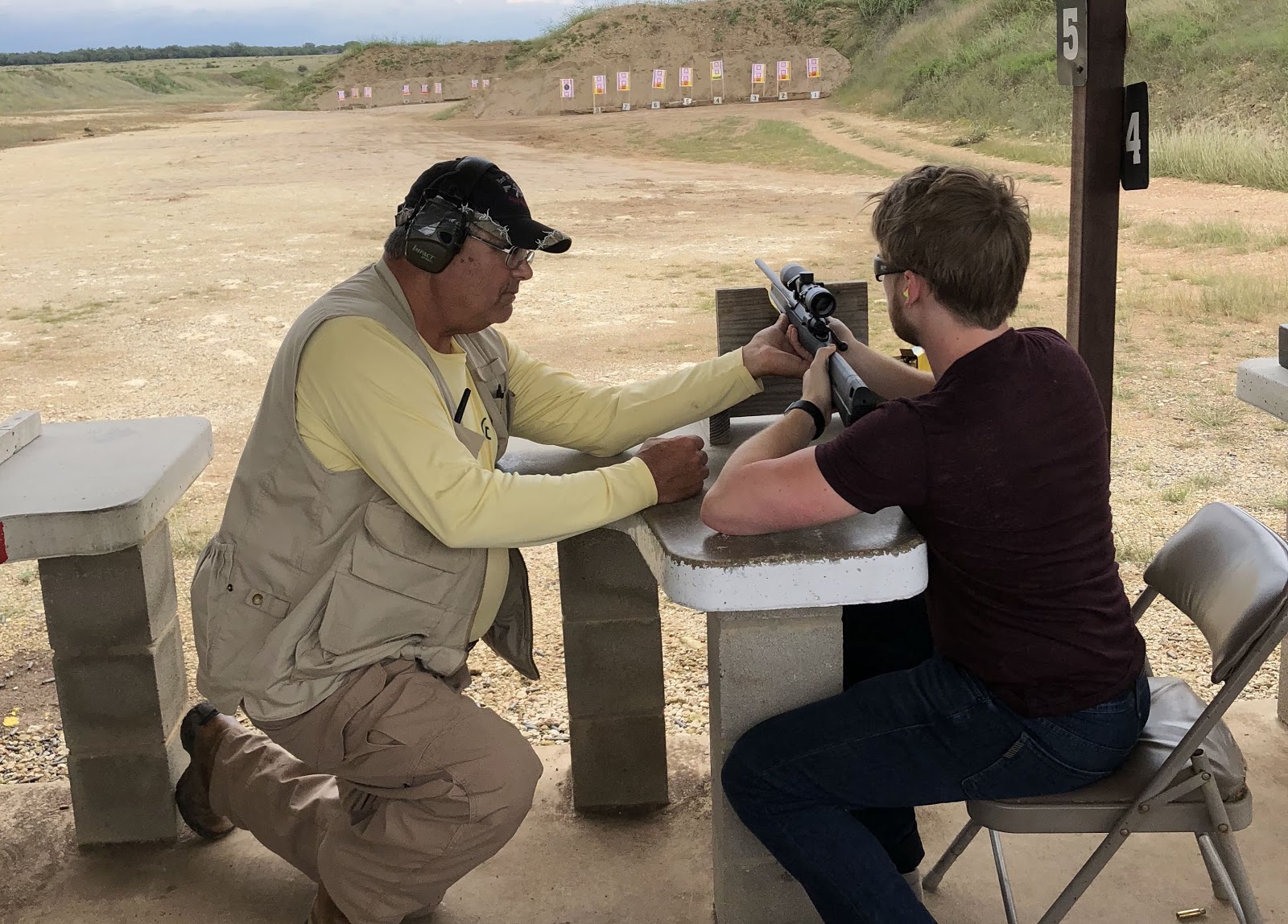
He helped us zero in our scopes so they were accurate for our rifles, work on not jerking the rifle while pulling the trigger, holding the rifle on the table to keep it as steady as possible, manage our breathing to stay on target, monitor our rifle temperature, everything we didn’t know we needed to do.
After three hours and forty bullets, I was feeling pretty good, but didn’t want to take any chances. I went home, bought a few more pieces of gear, and a week later we went out to a range closer to home to practice some more. This time, I managed to get 20 shots in a row within the required accuracy, so I felt good about my readiness for the trip.
I should mention that riflery is pretty fun on its own. It’s extremely satisfying to get a shot right on target, and there’s a certain thrill to dialing in your scope, trying to hold everything as steady as possible, controlling your breathing, and seeing such immediate feedback for your efforts. Even if you’re not going to go hunting, learning to shoot a rifle is a worthwhile experience.
But, obviously, the goal was to get good enough to go hunting, and a week later we were off to the Texas Hill country.
The Hunting Trip
Mansal had designed the hunt to be as comfortable and well-led as possible. We were staying in a beautiful 8-bedroom lodge overlooking a freshwater spring and the rolling hills of southern Texas.
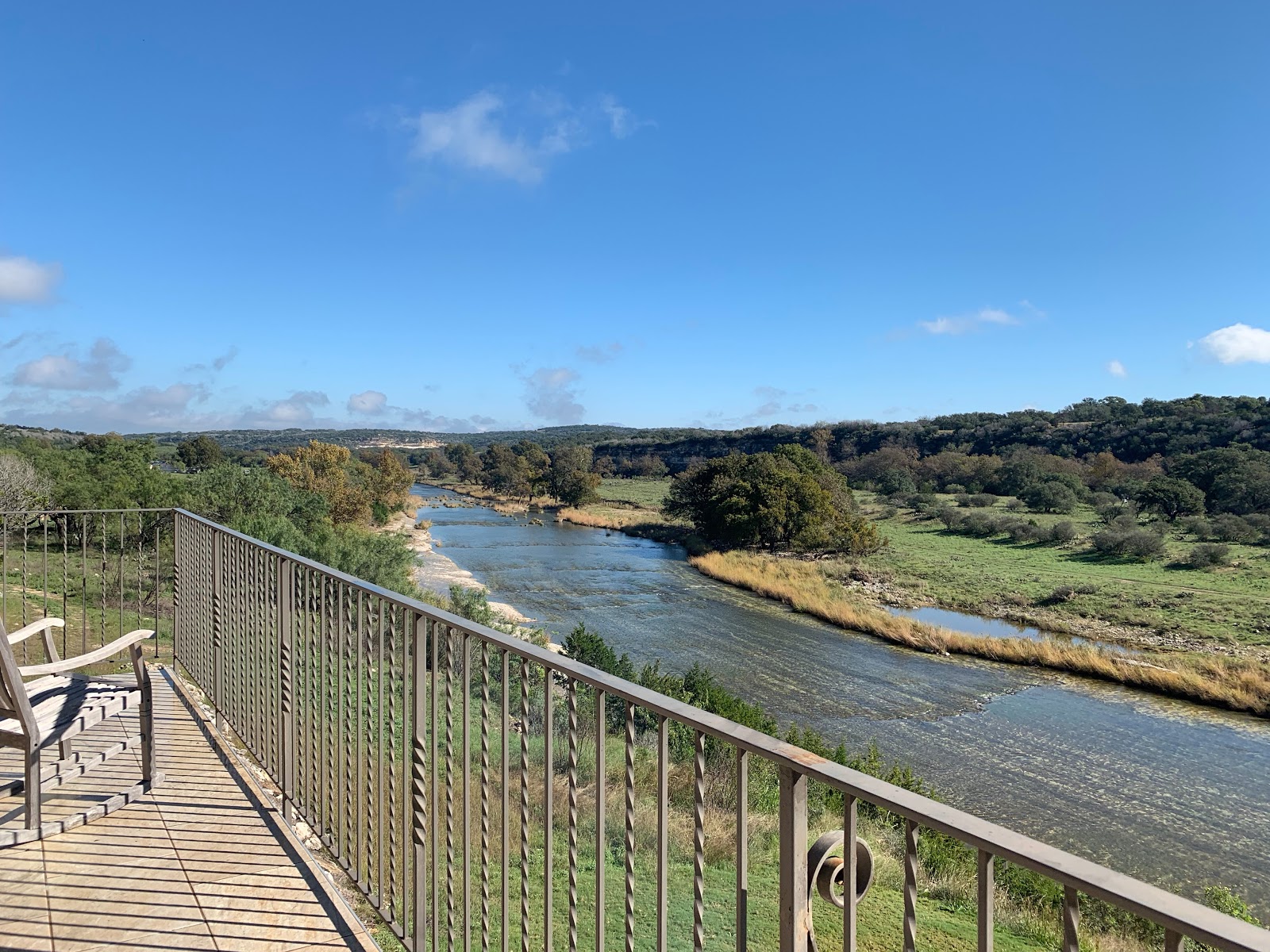
Along for the trip was myself, three other guys who hadn’t hunted before (Nick, Johnny, and Tim), a videographer (Chris), and a professional hunter Mansal had worked with before (Marc).
At the lodge, there were also three local hunting guides who took us out for the hunts, cooked our meals, and helped clean the animals. Since there were only four of us who were new to hunting, the three guides at the lodge plus Marc meant that every one of us could have a professional out with us while we were hunting.
The kind of hunting we were doing was primarily from blinds. Around the ranch, there were automatic feeders set up, with camouflaged hideouts ~100 yards away from them. The feeders would go off every morning and evening so the animals knew they could expect to find food there, and then we would hide out in the blinds waiting for the deer or boar to show up.
It’s definitely the most unfair to the animals of the different forms of hunting, but for first time hunters, it’s a great way to get your feet wet.
The First Hunt
We got to the lodge on Friday afternoon and immediately got our gear together to go out for the first evening hunt.
The feeders would go off around 7:30, so you wanted to be in the blind and comfortable by 6:30 at the latest to make sure you didn’t scare the animals off.
We loaded ourselves and our gear into the trucks and set off for our first hunt, with me, Mansal, and Levi (one of the guides) in a truck together.
Since Mansal was bow hunting, he needed to be much closer to the feeder, in a special bow hunting stand up in a tree about thirty yards from the feeder. We dropped him off first and let him get comfortable before going to our blind:
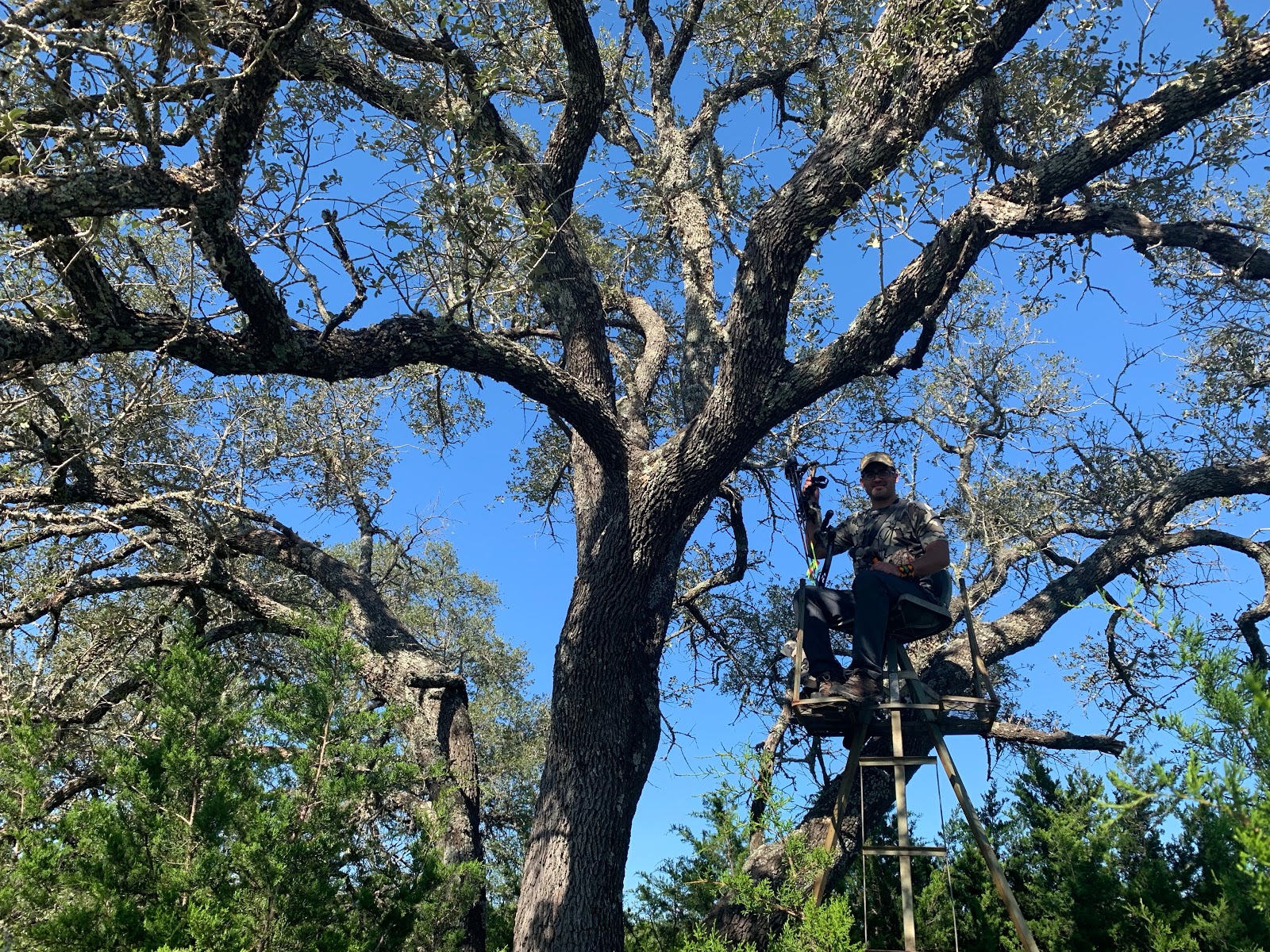
We got to our blind around 6:00 and settled in to wait for the feeder to go off. Waiting in the blinds is, honestly, a little boring. You don’t want to talk too much to avoid scaring off any animals, you can’t move much because you don’t want to risk them seeing the movement, and you can’t look at your phone or a book or anything since you need to be scanning for any movement.
Luckily, it’s beautiful out in the wilderness, and this was our view of the feeder and surrounding area:
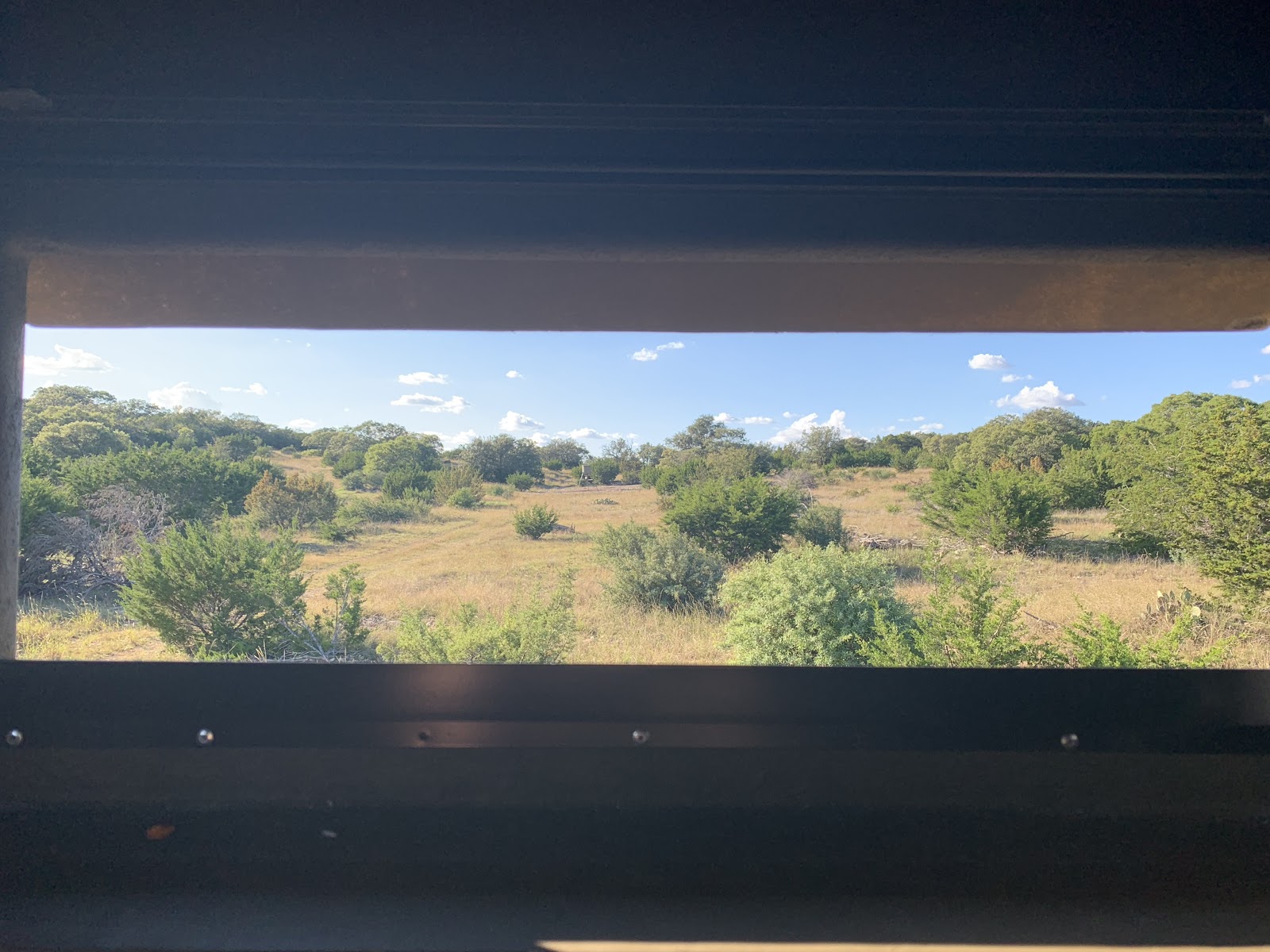
About half an hour before the feeder went off, a big buck showed up and started walking around checking things out. We weren’t hunting bucks on this trip, just does(1), so Levi and I watched him explore. Once the feeder went off he picked at the corn for five minutes until something spooked him and he ran back over the hills behind the feeder.
Another five or ten minutes later, two boars showed up, and started running around eating all the corn. Levi had explained that once boars show up, the deer won’t, since the boars tend to harass the deer, so we should go for a boar if we see one. One of them was pretty small, but the other was a good size, so I started following her around the feeder in my scope.
She kept running in circles around the feeder, barely stopping to eat for more than a second. I didn’t want to try to hit her while she was on the run, so all I could do was keep my eye on her. After a few minutes, she stopped to bend down and eat some corn giving me a perfect broadside shot, and I went for it. She squealed, the other boar ran off, and she dropped to the ground where she had been standing, dying almost instantly.
Levi and I gave her a few minutes before approaching, then climbed out of the blind and started walking. Boars can be vicious and dangerous, especially while wounded, so I had to walk in front with the rifle loaded in case she jumped up and charged us. When we got to her I poked her with the rifle, and when we confirmed she was dead, we could finally relax.
The only feeling I can use to describe the experience is “normal.” I didn’t feel any terrible remorse or sadness, and I didn’t feel particularly happy, it all just felt normal. Like it was something I was meant to do, which, biologically speaking, I am. I think the only other emotion was a sense of relief that she had died quickly.
We still had work to do, though, so we walked back to the truck, drove it up to the feeder, and loaded the boar in the back so we could take it back to the lodge.
Skinning and Quartering
Levi and I dropped the boar in the cooler by the lodge, and once we’d all eaten dinner, Levi, Jonathan (another guide), and I went out to skin and quarter her.
A big part of my goal for the trip was to experience every part of the process. Some hunters will shoot the animal and then let the guides quarter it and let a processor turn it into steaks and burger, but I wanted to go through the whole process at least once so I knew how to do it and everything that went into it.
There are three mains steps from dead animal to meat in your freezer:
- Skinning the animal
- Quartering the animal
- Processing the meat
Skinning is exactly what it sounds like: removing the skin.
Quartering is cutting off the limbs, as well as carving out the cuts of meat on the torso like the back straps, tenderloin, and ribs, while removing the guts, bones, and other parts you don’t want to eat.
Processing is taking the meat from quartering and turning it into steaks, burgers, ribs, and whatever other cuts you want.
The first two steps, skinning and quartering, were where I was most worried about getting grossed out of wanting to go hunting again. I’d never done anything close to it before, and was always a little queasy seeing photos or videos of animals being cut open online.
This, too, ended up feeling weirdly natural though. Once Johnathan got me started and showed me how to do the skinning and quartering, it felt like I’d done it all before. It was easy to get into the flow of doing it, and I managed to keep the boar’s skin in one piece all the way down to its head.
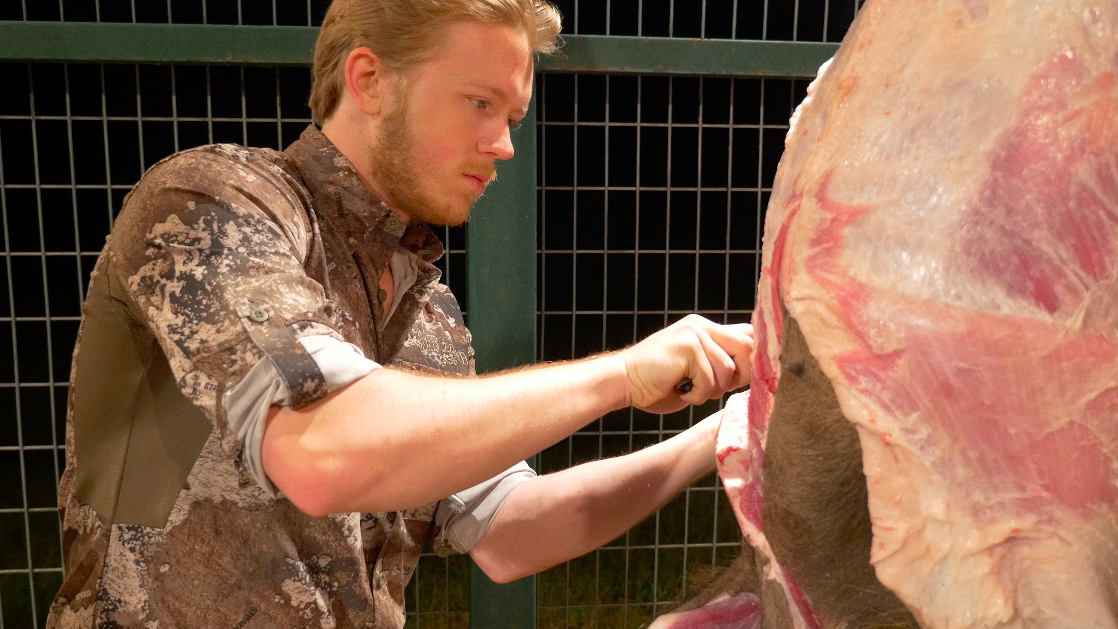
Thanks to Chris Duncan from Couraj for the action shots
Cutting out the meat felt oddly normal as well, and it was interesting to see where the different cuts of meat come from on a real animal. It also presented its own interesting challenge, trying to keep the nicer cuts as big and intact as possible as I cut them out.
The whole thing took about two hours (I suspect for someone more experienced it’d only take 30-45 minutes) and by the end of it I felt like I had a new appreciation for where each piece of meat comes from.
Processing
The next morning, we got up at 5:00 and went out to the blinds so we were in-place by 6:30 for the feeders to go off at 7:30. It was extremely foggy and I didn’t see a single animal all morning, so I was treated to this view for four hours:
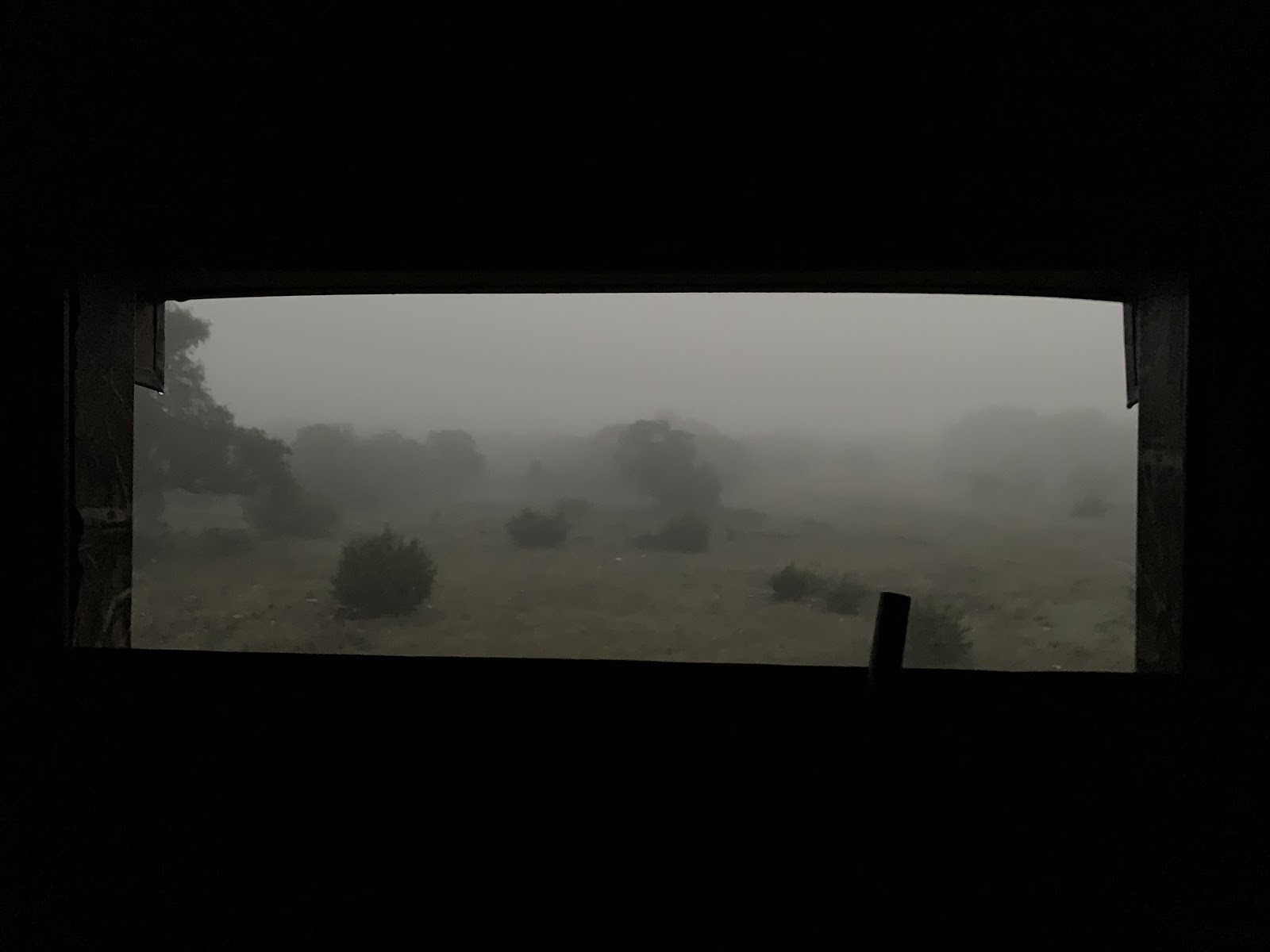
When we all came back from the morning hunt though, the other three guys had gotten their first kills, so we had a lot of meat that needed to be butchered.
We went back to the cooler area I’d been working in last night, and Marc gave us an in-depth course on skinning and quartering, building more on what I’d learned from Johnathan:
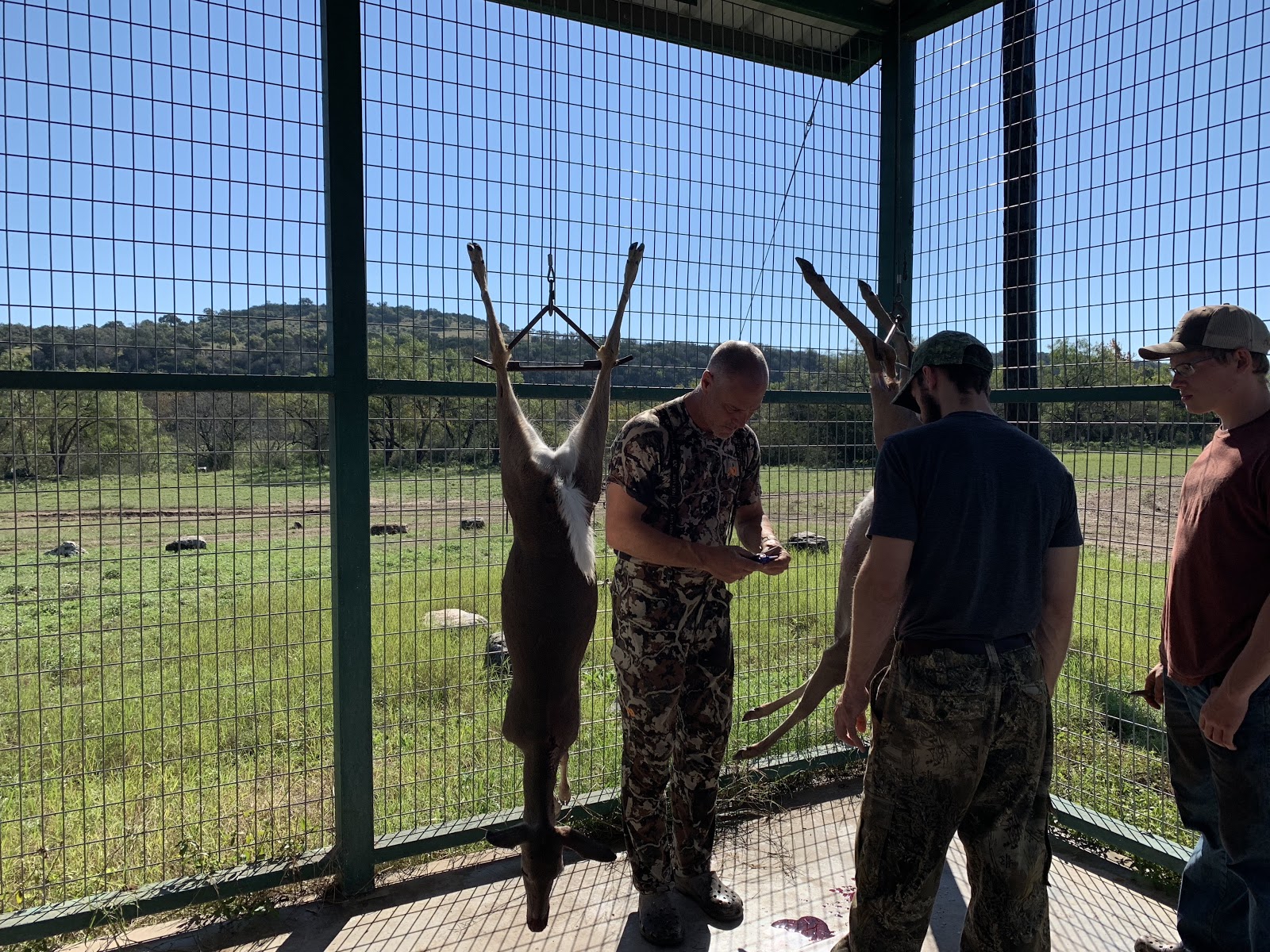
As we were finishing with the two deer and one boar that the guys had brought back, Marc started showing us how to process the meat. The first thing we needed to do was clean off the quarters and steaks, and cut out any tendon we could, to make the meat easier to eat:
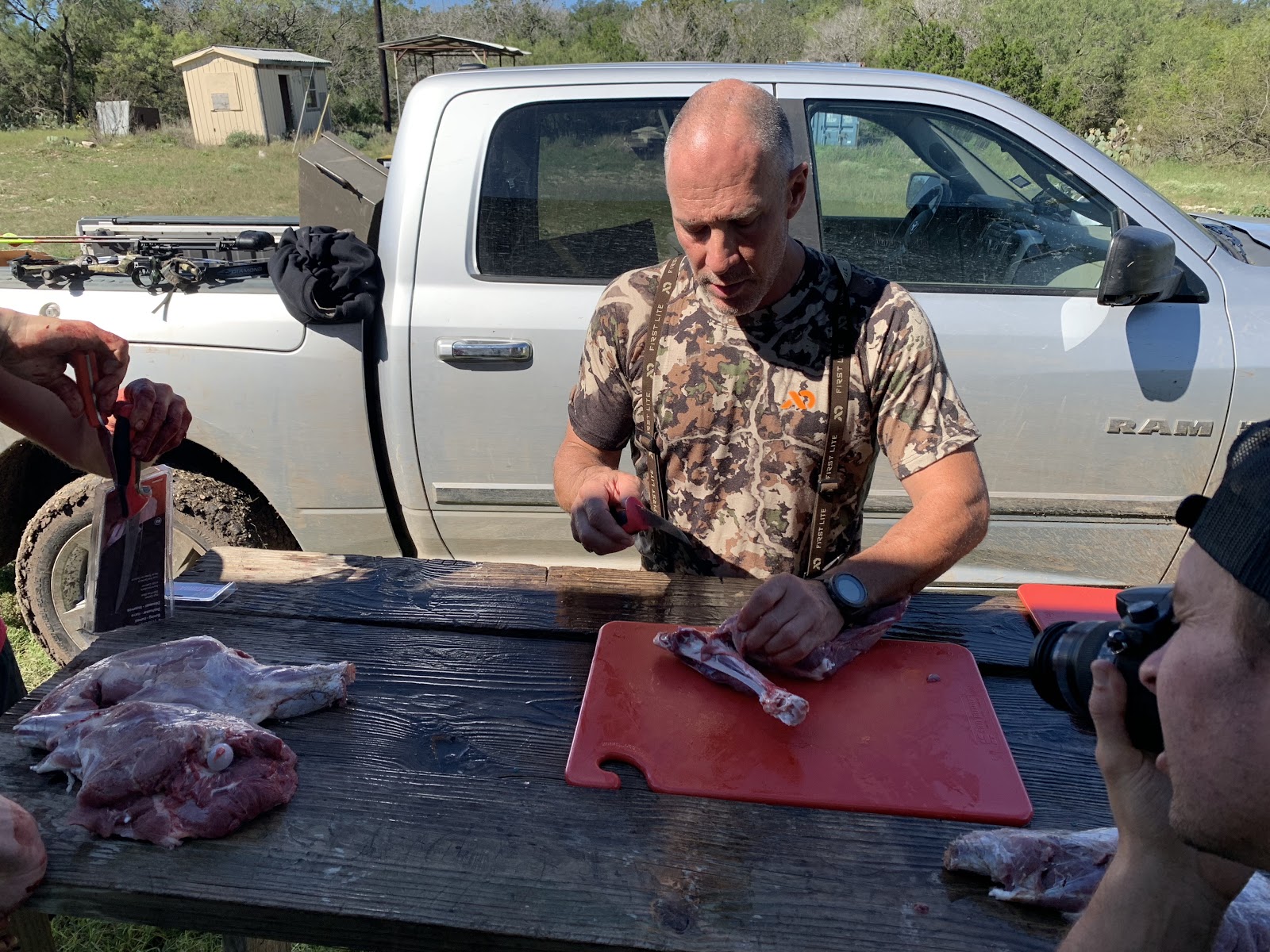
Once that was done, we brought all the meat back to the lodge to finish processing it. Mansal had brought a big meat grinder and vacuum sealer, so for the next couple hours we were cutting the steaks into serving-size pieces, grinding the rest of the meat into burger, and sealing everything in vacuum bags to go in our freezers:
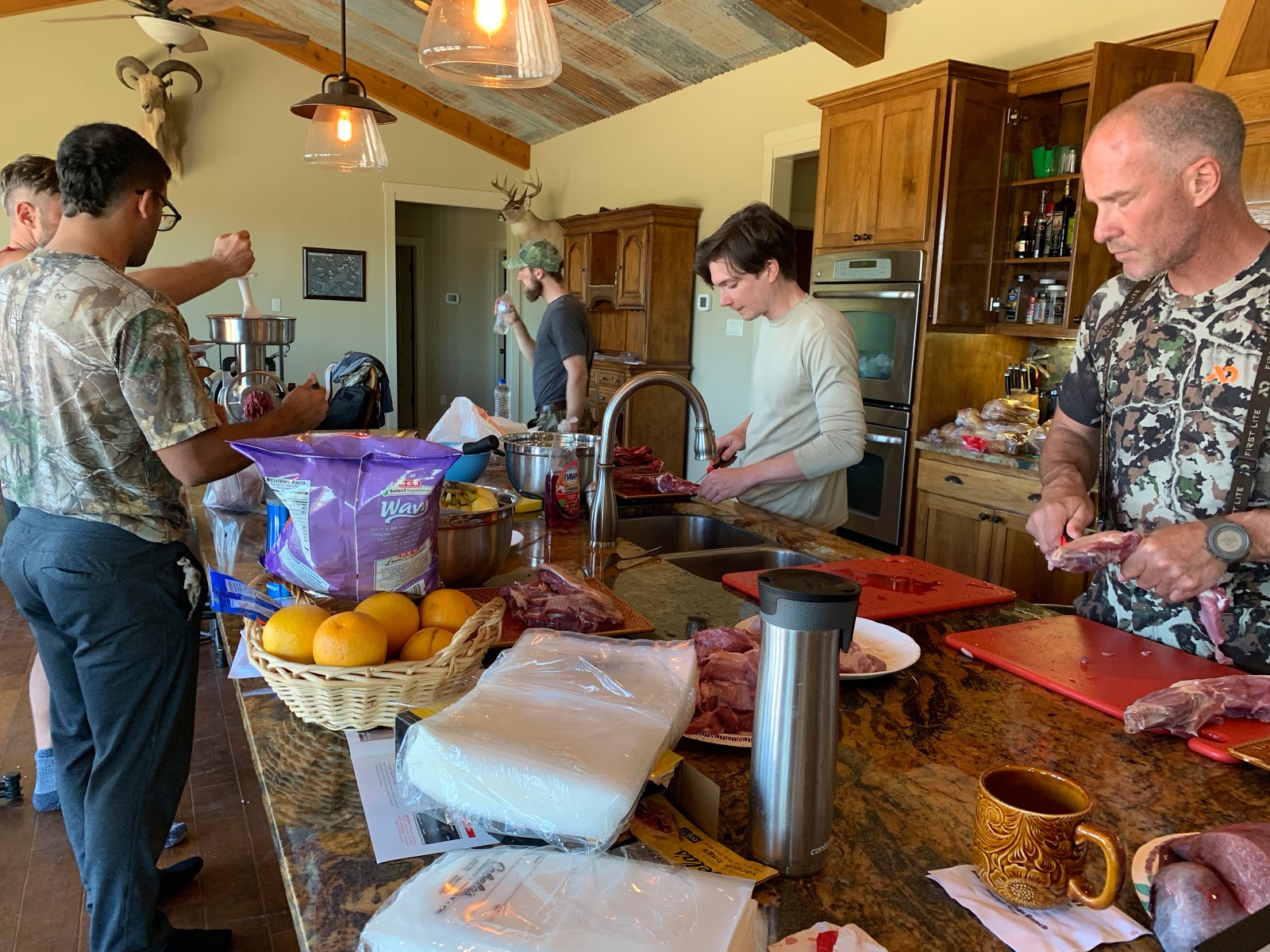
This part of the process was great to see and I’m glad I did it, but at the end of the two or three hours I was pretty over it. Hunting and quartering felt like I was really connecting with the animal, but then taking those chunks of meat and making them into smaller pieces didn’t feel as impactful.
Again, I’m glad I did it, but in the future, this is the part of the process I’d outsource.
Ethical Eating
I didn’t know what to expect going into this whole experience. I’d never used a hunting rifle, and never killed or butchered an animal. More than anything, I feel like I found a new appreciation for the meat that I eat, and a desire to eat meat from a good source whenever possible.
After that afternoon of meat processing, we went out two more times and I shot a deer both times. Seeing a dead deer is harder than a dead boar, they’re much cuter and easy to anthropomorphize, but again, it felt like it was a valuable experience.
Even if it’s difficult and emotional to kill an animal, I think everyone who eats meat should experience it. You don’t need to only eat meat you kill, or go hunting a few times a year, or even enjoy it, but taking an animal’s life to feed yourself is one of the most fundamental parts of our existence that’s become foreign to us, and there’s value in reconnecting with that process.
Looking forward, I think hunting will continue to be part of my life. I enjoy the challenge, the skill required, and the camaraderie of going out on the trips with my friends.
I also hope that other people will read this and consider trying hunting for themselves. I think Mansal is going to organize more of these trips for anyone in Austin (or who wants to visit Austin), and a trip like his would be a great way to get started.
Appendix: Gear
Here’s everything I picked up for the trip:
Savage Axis II XP 270 Caliber Rifle. Everyone I talked to agreed this was a good starting rifle. It comes with a scope built in which saves some headache and money, just be careful to make sure it’s well mounted. Mine was fine but Nick’s was loose and he had to get it remounted because it was moving around so much.
CVLIFE 6-9 Inches Tactical Rifle Bipod. This was a game changer for improving the rifle’s stability shooting while seated. You can use wood blocks and other props to hold it up, but the bipod is way more stable.
Rear Sniper Sandbag. Again, this is extremely useful for adjusting the rifle’s aim when you can rest the rear on a table or other surface. I didn’t end up using it during the hunt since I had to hold the butt of the rifle in the air, but it was very useful for dialing in the scope.
Noise Reduction Ear Muffs. Don’t want to lose your hearing. We didn’t use these while out hunting, but for practicing they’re essential. You can use smaller in-ear ones too, but I think these work better and are more comfortable.
Kylietech 12x42 Binoculars. These are just basic binoculars for scouting while out hunting. I used them a lot on the second day when I got to stalk for deer with Mark and Tim.
Plano Rifle Case. This plastic case worked fine, but it’s a little flimsy. I wouldn’t trust it for any series protection, but it worked fine for getting my rifle to the range and hunt and back.
Camo. I don’t have links to the exact pieces, but I got a full set of camo (shirt, pants, jacket, hat) by RedHead from Cabelas. I was really happy with it, I felt like I looked a little funny, but it was very comfy.

